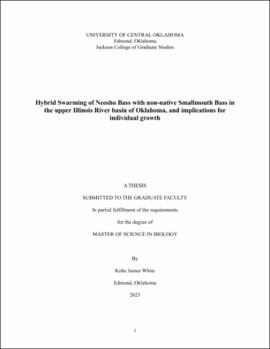| dc.contributor.advisor | Parks, Matthew | |
| dc.contributor.author | White, Kobe James | |
| dc.date.accessioned | 2023-06-26T16:55:39Z | |
| dc.date.available | 2023-06-26T16:55:39Z | |
| dc.date.issued | 2023 | |
| dc.identifier.other | (AlmaMMSId)9982957008202196 | |
| dc.identifier.uri | https://hdl.handle.net/11244/337839 | |
| dc.description.abstract | Recent molecular investigations support the distinctiveness of the Neosho Bass (Micropterus velox) of the Ozark Highlands from Smallmouth Bass (M. dolomieu). Like other endemic black basses, Neosho Bass are threatened by hybridization with non-native Micropterus forms. Non-native Smallmouth Bass were stocked in Lake Tenkiller in 1991 and 1992, resulting in introgressive hybridization with Neosho Bass in areas upstream of the impoundment. To inform management and conservation efforts, the main objectives of this thesis were to 1) characterize the spatial extent and directionality of introgressive hybridization, and 2) examine the influences of genetic identity on individual growth. From 2019-2021, specimens were collected longitudinally from localities along the Illinois River, Baron Fork, Caney Creek, Flint Creek, and Lake Tenkiller. We genotyped 1,272 fish with a SNP panel designed to identify Smallmouth Bass, Neosho Bass, and interspecific hybrids. Assignment of genotypes with STRUCTURE, NewHybrids, and introgress revealed an ongoing hybrid swarm in the Illinois River mainstem, with some areas of non-hybrid Neosho Bass remaining in far upstream reaches of smaller tributaries. For the second objective, three independent readers estimated the age of 650 fish using transversely sectioned sagittal otoliths. Fish ranged 67-536 mm in total length and estimated ages of these fish 0-10 years. Length-at-age data was then coupled with genetic results to parameterize von Bertalanffy growth functions. Analyses of von Bertalanffy growth functions revealed that estimated total length of non-hybrid Smallmouth Bass is noticeably larger than that of non-hybrid Neosho Bass beginning at age-1 and becomes increasingly divergent with age. The results of this thesis can be used to guide conservation plans for Neosho Bass across their narrow native range and to inform future management decisions regarding population dynamics of the sport fishery. In the future, we plan to couple our results with mitochondrial DNA (mtDNA) sequencing to provide additional insights into maternal ancestry of hybrids and the potential for directional introgression. | |
| dc.rights | All rights reserved by the author, who has granted UCO Chambers Library the non-exclusive right to share this material in its online repositories. Contact UCO Chambers Library's Digital Initiatives Working Group at diwg@uco.edu for the permission policy on the use, reproduction or distribution of this material. | |
| dc.subject.lcsh | Smallmouth bass--Hybridization--Illinois River (Ark. and Okla.) | |
| dc.subject.lcsh | Smallmoth bass--Illinois River (Ark. and Okla.)--Genetics | |
| dc.subject.lcsh | Smallmouth bass--Illinois River (Ark. and Okla.)--Growth | |
| dc.subject.lcsh | Smallmouth bass--Illinois River (Ark. and Okla.)--Geographical distribution | |
| dc.title | Hybrid swarming of Neosho Bass with non-native smallmouth bass in the Upper Illinois River basin of Oklahoma, and implications for individual growth | en_US |
| dc.type | Academic theses | |
| dc.contributor.committeeMember | Laverty, Sean | |
| dc.contributor.committeeMember | Long, James | |
| dc.contributor.committeeMember | Taylor, Andrew | |
| dc.thesis.degree | M.S., Biology | |
| dc.subject.keywords | Neosho bass | |
| dc.subject.keywords | Micropterus velox | |
| dc.subject.keywords | Wildlife conservation | |
| dc.subject.keywords | Wildlife management | |
| dc.identifier.oclc | (OCoLC)1386717113 | |
| thesis.degree.grantor | Jackson College of Graduate Studies | |
